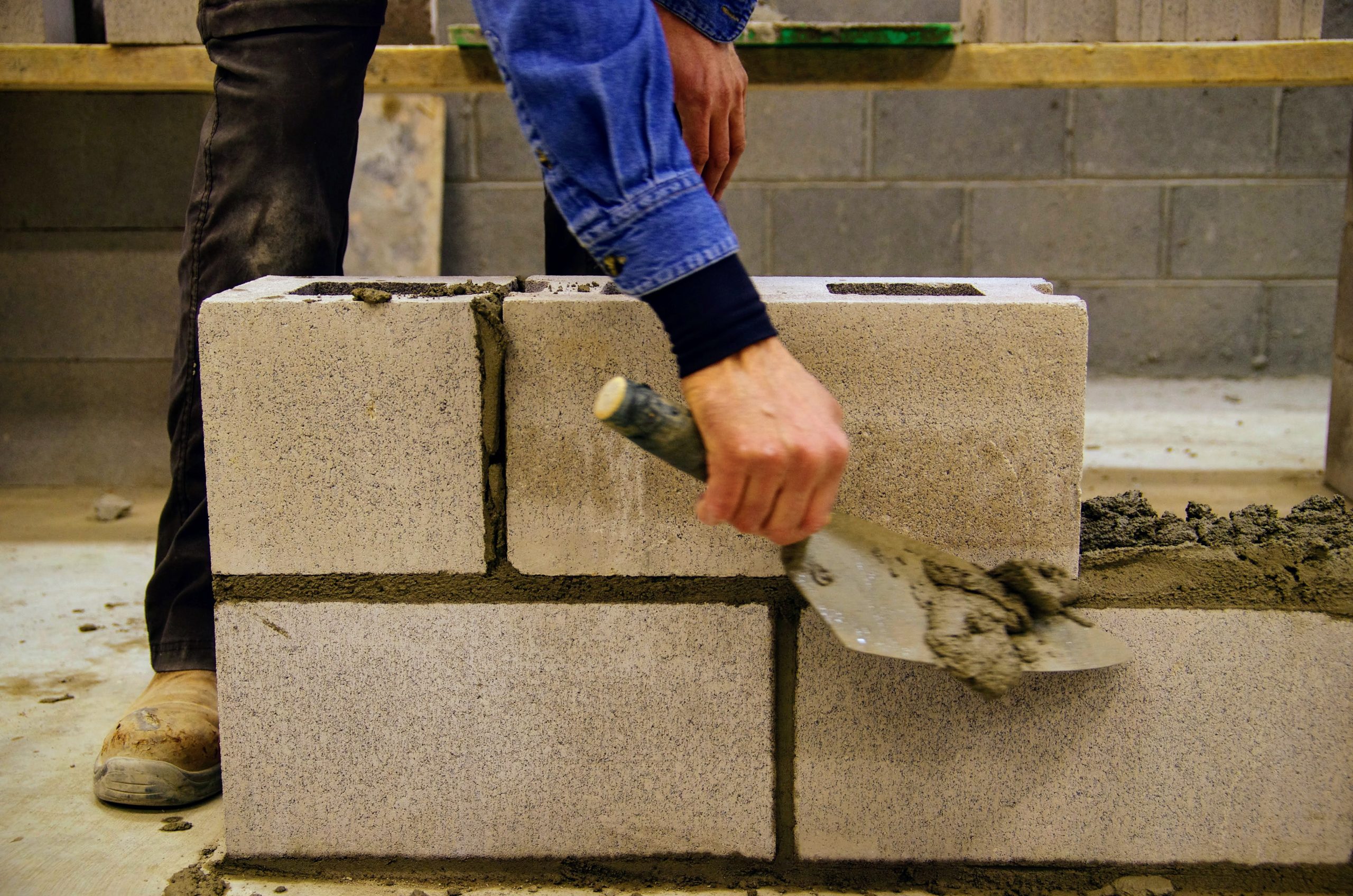Comprendre le mortier est important… même pour la maçonnerie non porteuses
La maçonnerie peut être utilisée pour toutes sortes d’applications qui ne sont pas considérées comme porteuses. L’utilisation de la brique, du bloc ou de la pierre comme revêtement est un excellent moyen d’améliorer l’esthétique, les performances et la durabilité d’un bâtiment. Par ailleurs, les cloisons en blocs de béton offrent une résistance supérieure au feu et au bruit. Cependant, certains points importants doivent être pris en considération lors de la spécification du mortier pour les applications non porteuses. Il arrive souvent qu’un type de mortier, tel le Type N ou le Type S, soit spécifié avec des exigences additionnelles, telle une résistance minimale à la compression Le but de cet article est d’expliquer pourquoi ce type d’exigence n’est pas recommandée, ainsi que les diverses méthodes disponibles pour spécifier un mortier de façon à en assurer la conformité aux normes et aux codes.
Une partie intégrante de notre série sur les devis descriptifs pour la maçonnerie
Des recommandations accompagnées d'explicatifs sur la manière dont elles ont été formulées. Nous tenons à remercier le comité technique de l’AEMQ pour son soutien pour la traduction de ce document. Cliquez ici pour voir la série complète.
Avis de non-responsabilité
Les informations présentées sont destinées à des fins éducatives pour les concepteurs, les prescripteurs ou les entrepreneurs. Il ne s'agit pas d'un avis technique formel, car les projets de maçonnerie peuvent comporter des détails et des considérations qui sont propres à un projet particulier et qui peuvent dépasser le cadre du contenu de cette page.
Recommandations
Le mortier de maçonnerie doit être spécifié selon les exigences relatives aux dosage ou bien selon ses propriétés, conformément à la norme CSA A179-14 : Mortier et coulis pour la maçonnerie en éléments. Dans presque tous les cas, le simple fait de spécifier le type de mortier (type S ou type N) et d’indiquer que le mortier doit répondre aux exigences de la norme CSA A179-14 pour la spécification selon le dosage, est suffisant pour les applications porteuses et non porteuses, sans qu’il soit nécessaire de spécifier une résistance minimale. Pour les parements en briques d’argile ou en béton, le mortier de type N est généralement spécifié. Les mortiers de type S sont généralement spécifiés pour les murs en blocs de béton. Des recommandations plus détaillées pour une sélection appropriée des mortiers peuvent être trouvées dans l’annexe A de la norme CSA A179.
Discussion sur la spécification du mortier pour la maçonnerie non porteuse
La spécification de la résistance à la compression minimum pour les mortiers et coulis constitue un exemple typique de devis descriptif problématique. Quoiqu’elles soient souvent incluses avec de bonnes intentions, ces exigences sont souvent contradictoires avec les normes de référence et peuvent causer des conflits sur le chantier et de graves problèmes dans le futur Il est important de reconnaître que le mortier et le coulis doivent être spécifiés selon l’une des deux voies de conformité distinctesla spécification de proportion ou la spécification de propriété, mais pas les deux.
Exemple de spécification potentiellement problématique :
L’article de devis ci-dessous est un exemple d’une combinaison typique d’exigences provenant à la fois de la spécification selon le dosage et selon les propriétés.
2.04 Mortiers
.1 Mortier pour ouvrages en maçonnerie extérieurs, au-dessus du niveau du sol :
.2 Maçonnerie porteuse : Type N selon les spécifications par dosage.
.1 La résistance minimale à la compression du mortier doit être de 12 MPa.
Les parcours de spécification selon le dosage et selon propriétés sont destinés à être utilisés séparément, l’un ou l’autre étant suffisant en soi. La résistance minimale à la compression est une propriété qui pourrait être en conflit avec les propriétés d’un mortier qui respecte par ailleurs les exigences pour le dosage. La résistance minimale de 12 MPa n’est pas non plus une résistance appropriée pour un mortier de type N.
Spécification selon le dosage
La spécification du dosage est de loin la méthode d’acceptation la plus souvent employée au Canada pour les mortiers et coulis. Dans ce cas-ci, le dosage des composantes du mortier (Type S ou Type N) doit être conforme aux exigences pour la spécification du dosage selon le tableau 3 ou le tableau 4 de la norme CSA A179-14. Le dosage normatif des composantes est prescrit dans la norme CSA A179-14 selon le type de mortier et le type de matériau (ciment Portland, ciment à maçonner ou ciment à mortier). La norme indique aussi d’autres exigences, y compris les caractéristiques granulométriques du sable et la méthode de malaxage du mortier. Des essais d’échantillons provenant du chantier pour un mortier spécifié par dosage peuvent inclure la détermination du rapport sable/liants ou la résistance à la compression d’un échantillon (cube) de mortier. Pour un mortier à proportion spécifiée il n’y a pas de valeur minimale de résistance à la compression qui doit être respectée. Les essais servent plutôt à comparer la résistance d’un échantillon provenant du chantier à une valeur de référence, établie avant le début des travaux, afin d’assurer l’uniformité des gâchées de mortier au cours du projet.
Pour les mortiers préparés sur le chantier lorsque des matériaux et des procédures conventionnels sont attendus, la spécification du dosage peut être spécifiée (CSA A179-14, la proportion des ingrédients est conforme au tableau 3 ou au tableau 4, selon le cas) et aucune valeur minimale de la résistance à la compression devrait être spécifiée.
Spécification selon les propriétés
Une voie d’acceptation moins souvent utilisée est la spécification des mortiers et des coulis selon les propriétés. Cette méthode d’acceptation est ouverte aux nouveaux mélanges qui ne se conforment pas à la spécification par dosage. Un exemple de ce type de produit est le mortier prêt à l’emploi (fabriqué et gâchés hors chantier) avec adjuvants pour allonger sa vie utile. Ces types de mortiers requièrent une vérification par essais pour s’assurer qu’ils offrent une performance au moins égale à celle des mortiers spécifiés selon le dosage. Ceci comprend de multiples essais, y compris des essais de la résistance à la compression par rapport à une valeur minimale. Il est à noter que cette résistance minimale est différente pour les mortiers préparés en chantier et préparés en laboratoire. Le tableau 6 de la norme CSA A179 indique les valeurs minimales de résistance à la compression des cubes de mortier à 7 jours et à 28 jours d’âge. Par exemple, pour un mortier de type S préparé sur le chantier, les valeurs minimales requises de résistance à la compression seraient de 5 MPa et de 8,5 MPa pour l’essai à 7 jours et à 28 jours d’âge, respectivement.
Pour les mortiers fabriqués hors site (comme les mortiers prêts à l’emploi), la spécification des propriétés doit être précisée, et une valeur minimale de la résistance à la compression peut être spécifiée, mais elle ne doit pas être inférieure aux exigences de résistance minimum du tableau 6 de la norme CSA A179-14. Il convient de noter que certains produits secs pré-emballés, pré-ensachés ou en silo contiennent simplement les composants d’un mortier spécifié selon le dosage, conformément au tableau 3 ou au tableau 4 de la norme CSA A179, et doivent être traités comme tels. Cependant, d’autres mortiers ensachés pré-mélangés contiennent des adjuvants et/ou d’autres composants et doivent répondre aux exigences de la norme CSA A179 par le biais de la spécification selon les propriétés.
Lorsque le concepteur exige l’introduction sur chantier d’un adjuvant ou d’autres matériaux pour améliorer la performance du mortier, il convient de suivre les exigences de la spécifications selon les propriétés. Dans ce cas, le concepteur doit travailler avec l’entrepreneur en maçonnerie pour mettre au point un mélange de mortier qui aura les propriétés requises. Il est possible de déterminer le dosage des granulats et des matériaux cimentaires dans le mortier (en contrôlant les procédures de dosage, de mélange et de manutention) ou de spécifier une valeur minimale de la résistance à la compression qui ne doit pas être inférieure aux exigences du tableau 6 de la norme CSA A179-14. Le contrôle des propriétés (c’est à dire, de la résistance à la compression de cubes de mortier) est souvent utilisé à la place du contrôle assidu du dosage, du malaxage et de la manipulation.
Normes applicables
Dans ce cas, comme pour la plupart des projets de construction, le devis doit inclure un revoie à la norme CSA A179. Enfin, il est important que les éditions les plus récentes des normes CSA pertinentes soient citées en référence. En cas d’incertitude, l’édition applicable de la norme est indiquée dans la liste de documents de référence du code du bâtiment en vigueur pour votre région. Pour l’édition courante du code national pour le bâtiment, le Code national du bâtiment du Canada 2015, les éditions pertinentes des normes CSA datent de 2014
Retour à la section Recommandations. Retour à la page des devis descriptifs.
Une partie intégrante de notre série sur les devis descriptifs pour la maçonnerie
Des recommandations accompagnées d'explicatifs sur la manière dont elles ont été formulées. Nous tenons à remercier le comité technique de l’AEMQ pour son soutien pour la traduction de ce document. Cliquez ici pour voir la série complète.

Vous avez une question sur l’un ou l’autre des thèmes abordés ici ?
Le CMDC est composée de bureaux répartis dans tout le Canada, qui vous apportent leur soutien par l’intermédiaire de notre personnel technique.
Éclaircir les devis et soulever des questions avant qu'elles ne se transforment en problèmes
Dans le cadre de nos efforts globals d'éducation de la communauté des concepteurs et de nos membres entrepreneurs, le CMDC a compilé une collection d'articles destinés à aborder les points communs d'incompréhension ou de confusion qui ont donné lieu à des problèmes.



